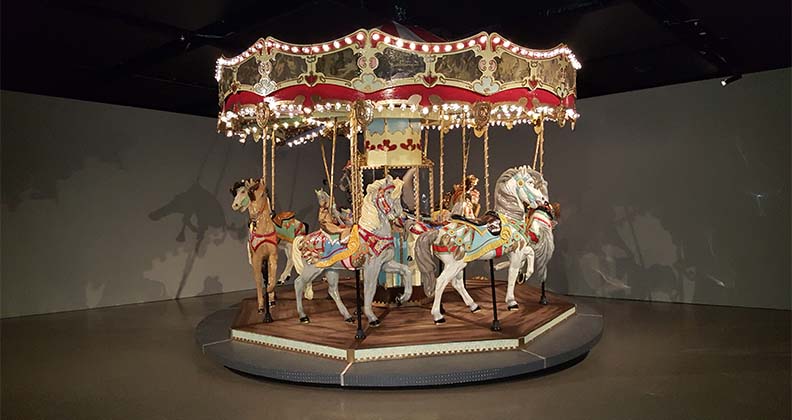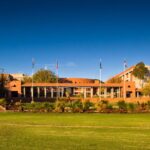In a world of conflict, political instability and social and cultural unrest, ‘PORTENT’ is an exhibition that represents turbulent and unpredictable times.
Comprising three pieces; each unique, thought-provoking and evocative, PORTENT showcases the artistic work of Curtin alumni Paul Caporn, Susan Flavell, and creative partners Tarryn Gill and Pilar Mata Dupont.
“This exhibition celebrates the work of four major Western Australian artists – all graduates of Curtin University. Collectively, they have won prestigious awards and public commissions, been acquired by leading institutions and featured in major art events around the world. All four are being acknowledged as part of Curtin University’s 50th Anniversary celebrations,” John Curtin Gallery director Chris Malcolm explains.
“PORTENT brings the work of four Western Australian artists together at a time when waves of anxiety shudder through populations around the world, some seemingly poised on the brink of catastrophe. In a world of increasingly widespread conflict, political instability and civil unrest, visitors are invited to consider the three works in this exhibition, all brimming with deeper realities that resonate with undercurrents of disquiet beneath the glimmering surfaces”.
Q&As with ‘PORTENT’ artists
Alumnus, Paul Caporn
Paul Caporn’s Roundabout is a monumental sculptural installation of a disintegrating merry-go-round suspended in time, just at the threshold of everything going horribly wrong.
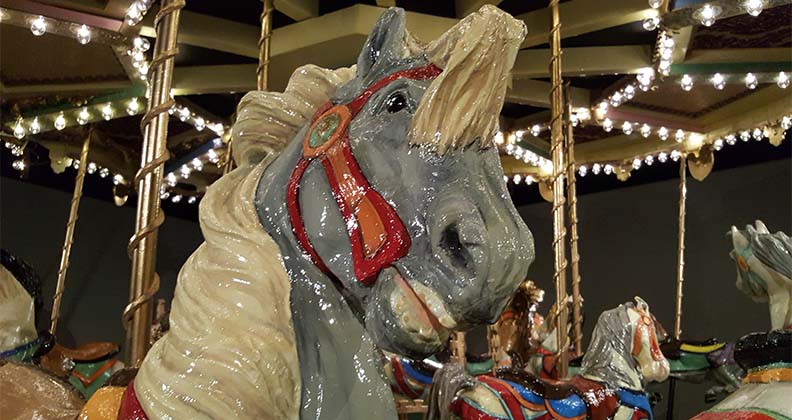
Q: What inspired you to create this piece and what does it represent?
A: The inspiration for the work is drawn from a variety of places including the fairground and amusement parks, cathedrals, architecture and the contemporary gallery space. Gallery spaces have become places where the search for meaning or the understanding of existence can be explored, without the need for a singular notion of god.
My thoughts and ideas shifted throughout the development of the piece. The difficulty and debate is expressed through the turmoil in the work. As the work unravels and comes apart, so does its meaning.
One of the people who helped me on this work was past Curtin Guild President, Peter Ellis. He unfortunately passed away a few weeks before the opening of the exhibition and I dedicated the installation to his memory.
Q: How long did it take, and exactly what is it made of?
A: The work has been developed over the past four years with the predominant part of the fabrication being completed over two years. The work is mostly made from cardboard tissue paper and binder medium (paint), with some structure from timber and polyurethane foam.
Q: How did your time at Curtin help shape you as an artist?
A: I first completed a fine arts degree in 1992 and then a visual arts qualification first class honours in 2004. My career as an artist was greatly influenced by various mentors and lecturers during my time at Curtin. Other students and the overall University environment enabled a culture of experimentation and open critical debate that has been fundamental to my ongoing artistic practice.
Alumna, Susan Flavell
Susan Flavell’s The Horn of the Moon is the first in a series of thirteen large sculptural works depicting goddesses, and explores ideas of the sacred, antiquities, mythologies and storytelling.
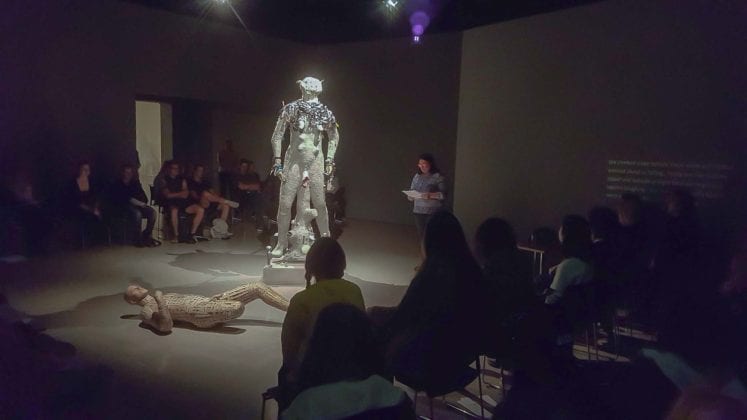
Q: This piece is about goddesses telling a story. What story is the goddess in The Horn of the Moon telling?
A: The Horn of the Moon is telling the story of our relationship with nature, our romantic notions regarding the environment and our destruction of it; our interconnected relations with other animals, plants and places. The starting point was Kali, the Indian goddess of destruction and creation, who is often depicted standing on her consort wearing a necklace of skulls.
The figures reference the history of sculpture, and the materials carry a range of complex connotations, meanings and symbolism. From rubbish picked up in the street or in the bush, to things of value, things found and made, objects donated in a spirit of collaboration, Banksia bark collected at the site of the Roe 8 protests and squares of beeliar blue fabric.
Q: This is the first of thirteen pieces – can you provide readers with a hint about the next installment?
A: I am currently working on The Foaming Star – a sea goddess – which will explore our relations with the sea, the beginnings of life, the beauty, the mystery, our fears of sea monsters and the unpredictable nature of being at sea.
Q: In what way did your Curtin degree expand your creative horizons?
A: I completed a Bachelor of Arts (Fine Art) in 1985. I also completed an honours year in 1995. Education is always a good idea, and an on-going activity for an artist. Arriving at art school as a very young 18-year-old was like finding my people and my place in the world.
Alumna, Tarryn Gill
Tarryn Gill and creative partner Pilar Mata Dupont are visual artists whose award-winning collaborative video work Gymnasium was part of their Stadium Series that featured photographic video and performance-based works.
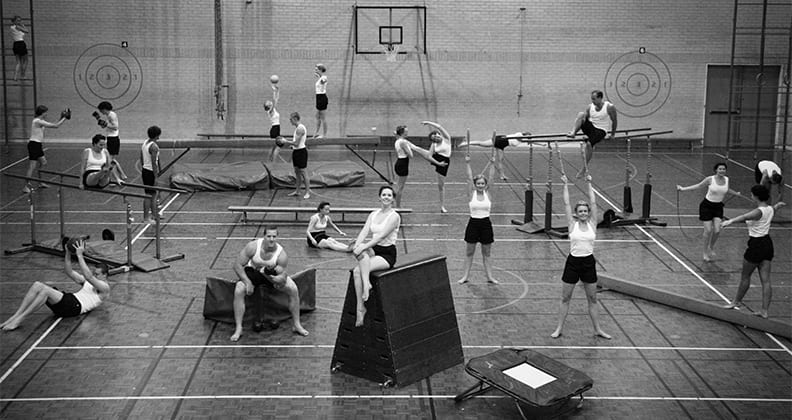
Q: What story is Gymnasium telling the audience?
A: With backgrounds in dance and music theatre, Pilar and I developed a collaborative practice that encompasses photography, performance, film, installation and theatre. We have shared our fascination with past eras by constructing luscious, nostalgic visuals and using them to critique histories of nationalism in contemporary Australian culture.
In Gymnasium, we explored the cult of heroic athleticism. We wanted to evoke a golden age of the gym, presenting scenes of fresh-faced athletes performing rhythmic routines in a simple, archaic gym. The piece uses language from the Hollywood Musical Revue and the visual complexity of a Busby Berkeley musical of the 1930s – clockwork choreography, extended depth of field and patterned mise-en-scène – combined to synchronise individual athletes in time and space.
These seductive visual effects have their dark side. In the piece, we cite Nazi propaganda films by adopting similar filmmaking and editing techniques for Gymnasium. The synchronisation of individual performers into a single entity was also integral to Fascist aesthetics in the 1930s and 40s. The alluring visual effects of Leni Riefenstahl’s Olympia suggest a sinister subtext in sport.
In Gymnasium, we’re suggesting that contemporary Australia’s national obsession with sport and our tendency to embody our collective character in national teams carries with it the risk of mob politics.
Q: How has your Curtin qualification assisted you in your professional and artistic journey?
A: I studied a fine arts degree, graduating in 2001. My Curtin course contributed significantly to my professional journey because Pilar and I met at Curtin art school and began our collaboration as students. It was also important because it allowed us to make connections to the Perth art community.
‘PORTENT’ runs until 3 December at the John Curtin Gallery, Bentley Campus. For more information, visit the John Curtin Gallery website.
